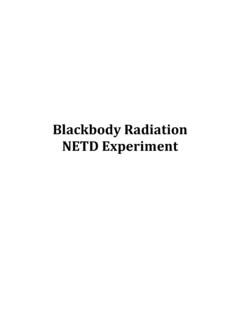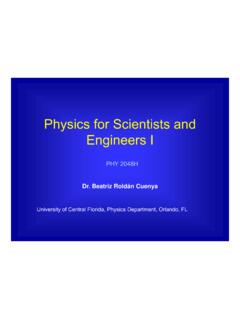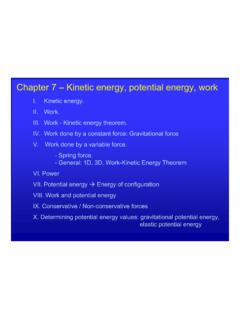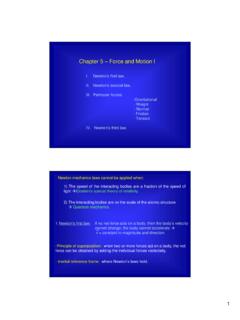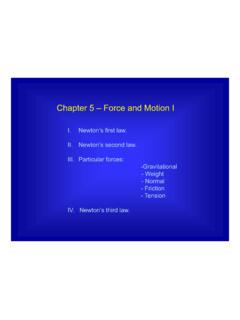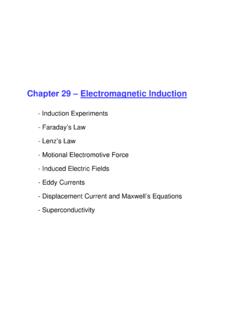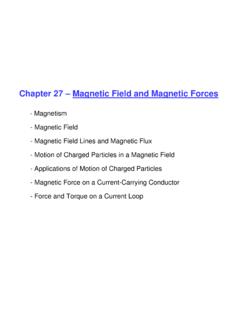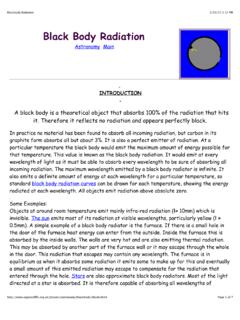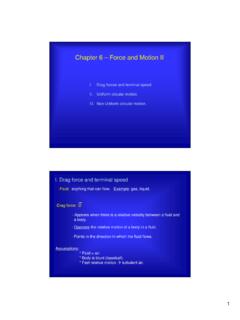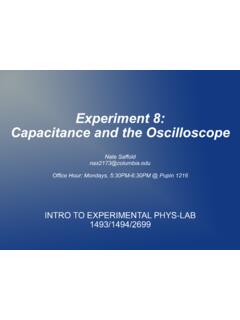Transcription of Chapter 24 – Capacitance and Dielectrics
1 Chapter 24 Capacitance and Dielectrics - Capacitors and Capacitance - Capacitors in series and parallel- Energy storage in capacitors and electric field energy- Dielectrics - Molecular model of induced charge- Gauss law in dielectrics1. Capacitors and CapacitanceCapacitor:device that stores electric potential energy and electric charge. - Two conductors separated by an insulator form a capacitor. - The net charge on a capacitor is zero. - To charge a capacitor -| |-, wires are connected to the opposite sides of a battery is disconnected once the charges Q and Q are established on the conductors.
2 This gives a fixed potentialdifference Vab= voltage of :constant equal to the ratio of the charge on each conductor to the potential differencebetween :1 Farad (F) = Q/V = C2/J = C2/N m- Capacitance is a measurement of the ability of capacitor to store energy(V = U / q).Capacitors in Vacuum- Parallel Plate Capacitor: uniform electric field between the plates, chargeuniformly distributed over opposite surfacesAQEoo ==dAVQCab0 ==AQddEVoab 1= = 0= x 10-12F/m- The Capacitance depends only on the geometry of the Capacitors in Series and ParallelCapacitors in Series:- Same charge (Q).
3 Vab= Vac+ VcbEquivalent capacitor212121111 CCQVQVCVVQVQC eqabeq+=+= +==Capacitors in Parallel:- Same potential V, different charge. Q1= C1V1Q2= C2V2212121 CCVQVQCVQQVQC eqabeq+=+= +==Equivalent capacitorQ = Q1+Q23. Energy Stored in Capacitors and Electric-Field Energy- The electric potential energy stored in a charged capacitor is equal to theamount of work required to charge = ==CQdqqCdWWQW21200 = ==Work to charge a capacitor:- Work done by the electric field on the charge when the capacitor If U = 0 for uncharged capacitor W = U of charged capacitor22222 QVCVCQU===Potential energy stored in a capacitor:Electric-Field Energy.
4 - A capacitor is charged by moving electrons from one plate to requires doing work against the electric field between the plates. Energy density: energy per unit volume stored in the space between the plates of a parallel-plate =dAC0 =dEV =dACVu =221 Electric Energy Density (vacuum):- Non-conducting materials between the plates of a capacitor. They change the potential difference between the plates of the capacitor. 4. Dielectrics -The dielectric layer increases the maximum potential difference between the plates of a capacitor and allows to store more breakdown: partial ionization of an insulating material subjected to a large electric constant (K).
5 0 CCK=C = Capacitance with the dielectric inside the plates of the capacitorC0= Capacitance with vacuum between the plates- If Q = constant Q = C0 V0 = C V C/C0= V0/VKVV0=- No real dielectric is a perfect insulator always leakage current between charged plates of a capacitor with a Charge and Polarization:Field lines change in the presenceof Dielectrics .(Q constant)KEE0=E = field with the dielectric between platesE0= field with vacuum between the plates- E is smaller when the dielectric is present surface charge density smaller.
6 The surface charge on conducting plates does not change, but an induced chargeof opposite sign appears on each surface of the dielectric. The dielectric remains electrically neutral (only charge redistribution).Polarization: redistribution of charge withina induced surface density in the dielectric of a capacitor is directly proportional to the electric field magnitude in the material. Net charge on capacitor plates: ( - i) (with i = induced surface charge density)00 =E00 iKEE == =Ki11 Induced surface charge density:Permittivity of the dielectric:0 K= =EdAdAKCKC == =00 Capacitance of parallel platecapacitor (dielectric present):Electric energy density (dielectric present):2202121 EEKu == Electric field (dielectric present):A very strong electrical field can exceed the strength of the dielectric to contain breakdown:5.
7 Molecular Model of Induced ChargePolar moleculeNon-polar moleculeInduced dipole Polarization and Electric Field LinesPolarization of a dielectric in electric field gives rise to bound chargeson the surfaces, creating i, - neutral sphere B in the radial electric field of a positively charged sphere A is attracted to the charge because of )( AQEA iencl ==6. Gauss s Law in Dielectrics00)( AQEA iencl ==0 KAEA = =Ki11 0 AKEA =Flux through Gaussian surface (enclosed free charge / 0)Gauss Law in a dielectric: 0 freeenclQAdEK =
